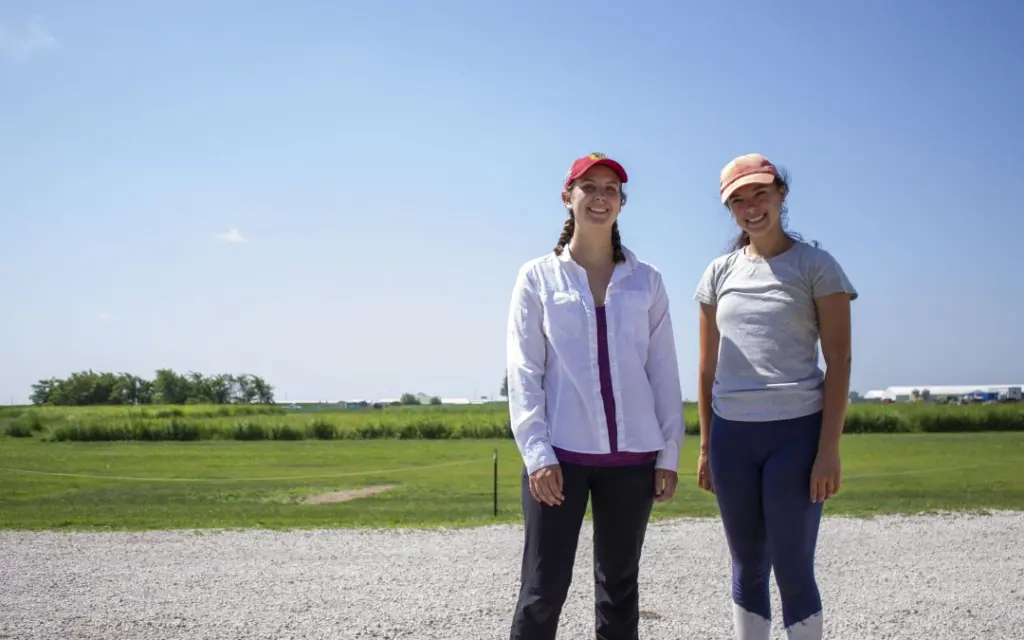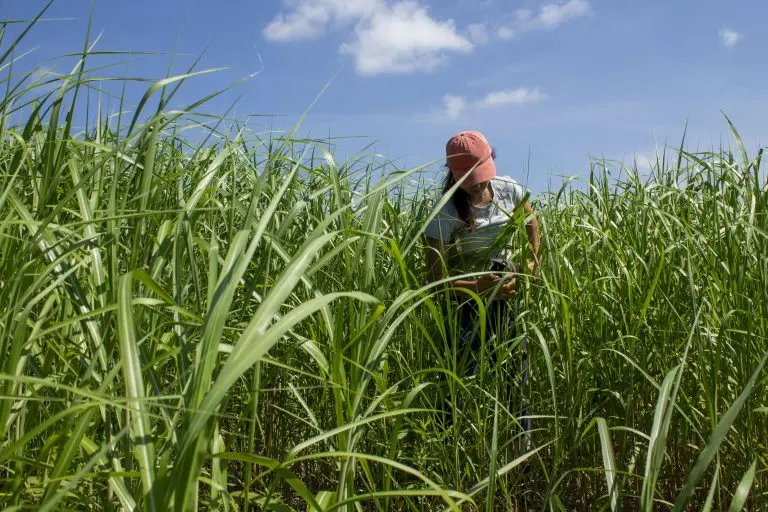
When it comes to the future of sustainable bioenergy crops, the most important part might also be the most well-hidden.
This past summer, the Illinois Energy Farm hosted a research team hailing from Boston University (BU) working in CABBI Co-PI Adrien Finzi’s lab. Ryan Quinn and Julia Masterman traveled from the East Coast to the Midwestern heartland to do some digging into what’s going on below the surface of bioenergy.
Working under CABBI’s Sustainability Theme, the Finzi Lab’s approach to studying bioenergy plants is to start with the subsurface. By studying belowground processes — root growth, morphology, and carbon sequestration, to name a few — researchers can ultimately make bioenergy agriculture a more sustainable process.

“If we can understand how carbon is being allocated belowground, we’ll have a better understanding of how these crops will be sustainable in the long term, from a carbon emissions standpoint,” Quinn explained.
In the past, the Finzi Lab has studied belowground carbon cycling in both forest and wetland ecosystems. Now, team members are expanding in scope and scale to include agricultural systems. Specifically, bioenergy crops.
“This is an exciting opportunity for our research group. The ability to work in America’s agricultural system is potentially the most impactful work we will do,” Finzi said.
Enter Quinn and Masterman. Quinn — currently pursuing her Ph.D. in BU’s Biology Department — studied how soil chemistry affected methane emissions from tropical soils at Oak Ridge National Laboratory prior to joining CABBI in September 2018. Masterman, who received her bachelor’s degree in Earth and Environmental Sciences in Spring 2019, became interested in the project after taking an undergraduate course taught by Finzi. The duo’s wealth of diverse experiences, knowledge of natural systems, and enthusiasm for rigorous field work set them up to take on a challenge that’s new for both the scientists and their lab alike: conducting research in an agricultural system.
When studying belowground processes of field crops, roots are the name of the game.
Specifically, the roots of sorghum and miscanthus. It’s a good thing Quinn and Masterman have no qualms with field work — rain or shine, in the beating sun or in the trademark Midwestern winds, the team was out on the Energy Farm using three different methods to glean as much root-related information as possible. From growth and death rates to density and branching patterns, any and all information is critical to obtaining a comprehensive understanding.
“The way I describe (my research) to friends and family is that I’m digging holes in different shapes and sizes, and taking different kinds of pictures of roots,” Masterman said.

The first method for data collection is exactly that: Using observation windows — strategically-placed holes distributed throughout the sorghum and miscanthus fields — the researchers can simply look inside to experience a firsthand view of new developments occurring in the soil. And, of course, the occasional silt, spiders, and unexpected surprises that come with the territory. (According to Masterman, frogs and field mice can be “cute when expected, not so much when unexpected.”)
For the roots that are too deep to see through observation windows, the team uses minirhizotron imaging. A tractor positions a PVC pipe roughly a meter into the ground, which allows the surrounding soil to be documented continuously throughout the summer.
“We can see the roots through the PVC pipe, so we’ll take pictures of the same location in the soil all summer, and that will allow us to look at the roots as they grow and die and establish traits throughout their lifecycle such as diameter and branching order,” Quinn said.
The third method of data collection deals not only with the roots themselves, but with what surrounds them: soil. Throughout the summer, the team collected various soil samples from different depths and locations, to ultimately bring back to Boston and analyze in the lab. The samples will help the researchers measure root biomass and determine carbon sequestration levels.
Being out in the field day in and day out comes with its own set of challenges — but both scientists saw this as only a positive.
“That’s what I love about science,” Masterman said. “So much of that problem-solving when you’re in the field is thinking on your feet. You’re like, ‘Okay, what materials do I have to face this very specific problem?’ ”
Quinn appreciates the Energy Farm’s unique brand of field work for a different reason: After working in diverse ecosystems worldwide, her first foray into agriculture is proving to be a favorite.

“I really like that the Energy Farm is a controlled, flat, easy system to work in. I’ve worked in wetlands before — here, you don’t have to time yourself to make sure you’re out at low tide!”
As Quinn and Masterman wrapped up their time on the Energy Farm and prepared to head back east — Quinn to continue her Ph.D. and Masterman to explore possible master’s programs — they were excited to see what the future has in store for their pioneering research. According to Quinn, there is a lot to look forward to.
“People are always asking: Is agricultural bioenergy going to be sustainable in the long term?” she said. “But there’s never been a huge focus on what’s going on belowground.”
Now, the Finzi Lab, along with Masterman and Quinn, are changing that.
“We will have no clear understanding of whether bioenergy crops will be sustainable, or how sustainable,” Quinn said, “until belowground carbon allocation is looked at more thoroughly.”
— Article and photos by iSEE Communications Specialist Jenna Kurtzweil